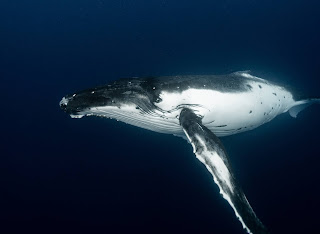Things You Should Know About Blue Whale.
Blue Whale size
Blue whales are 20 to 2 5 meters in length. It is a mammal. It weighs 80 to 90 tons. The lifespan of a whale is 60 to 80 years. She gives birth to a cub once every two to three years. The giant mammal Slateia is blue in color. The lower part of the body of some blue whales is blue. The head of this whale is longer than that of other whales. It has 80 to 90 grooves in the neck. Its main food is sea creatures like krills, amphipods, copepods and cephalopods. It sometimes strains in both the Kutch and Khambhat gulfs of Gujarat. It is found in the open sea off the coast. Whales are more in pairs. Keeps making long sea voyages. It has dark black ballin plates in its mouth which makes it recognizable immediately. Blue whales are not toothed like sperm whales. He puts a lot of water in his mouth and closes his jaw and draws water out of the small crack. Small sea creatures that live in the mouth with water stay in the mouth which the whales go healthy.
The largest animal in the world is the blue whale. The largest animal on earth is the elephant but it weighs as much as the tongue of a blue whale. Usually we talk about whales. But the blue whale is actually a marine mammal in the Timingal range. It covers the open and cold water coastal areas of Gujarat, Maharashtra, Kerala, Karnataka, Tamil Nadu and Andhra Pradesh in India. Kathiawad in 1993th, Ummargam in 1951, Ganesh village in 1960, Surat in 1963, Kalubhar Island in 1988 have been reported to have experienced blue whale tension on the coast of Gujarat during different years.
Where is Blue Whale found in india
Blue whales are found in different areas in the usual changing colors such as blue – gray, black gray – gray to blue. His stomach may be white or yellow. A light blue color from the neck that extends from the flippers to the abdomen. The body is very wide and looks like an English ‘U’ shape when viewed from above the head. There are very small fins on the lower back all over the body. There is no hair anywhere on the whole body. A few hairs are found only around the lips. Flippers are long and flat. Which is about one-seventh the length of the body. There are 80 to 100 grooves near the anus.
Blue whales float in the open ocean in groups of two or more during the day. Migrates from the Arctic to the latitudes of Antarctica in summer. Where planktonic stratospheric organisms are found in large numbers. While in the winter they migrate to the tropics for mating and rearing. The main food is stratified creatures like krill and prawn. As it floats, it opens its wide mouth and fills it with water, including such creatures. Water from its mouth is excreted through the bile duct and the creatures remain in the mouth after swallowing. Blue whales do not have teeth.
What a blue whale eat
The blue whale cub is about 23 feet long at birth and weighs 2500 to 3000 kg. The maximum weight of a blue whale is recorded to be 20,000 kg. If it had not been hunted, it could have been found to be up to 30.5 meters long and have an average weight of 16,000 kg. Large adult blue whales can eat 4,000 to 8,000 kg of krill in a day. The blue whale transmits its messages over long distances by generating ultrasonic waves in seawater. This giant creature is included in the list of endangered species due to the noise of sea ships, ships and submarines, fishing and large scale hunting.
This whale of the Timingal range is also a marine mammal. The second largest whale after the Blue Whale is the Indian Finy Whale. Found in the eastern and western coastal areas of India. The whale’s lips are two-colored. The lower lip is dark gray and the right is white. The abdomen is white in color and the pit of the neck reaches the part of the dunti. The lower part of the back has a small pointed fin from where an upturned body part reaches the tail. That is why it is also called ‘Rammer Back’. The frontal appendages are transformed into flippers. Which are thin and small. Its mouth is as long and narrow as the English ‘V’ shape. The top of the head is flat. The anus has 8 to 100 grooves which can be seen up to the nipple or above. The back and sides of the body are dark gray to brownish black in color. The head is white, disproportionately colored. There are 260 to 480 billin plates on both sides. It has more “blink plates” than blue whales. These whales are not toothed so they prey on aquatic organisms. It is found in small groups of 3 to 7 and sometimes in numbers up to 100. The whale

